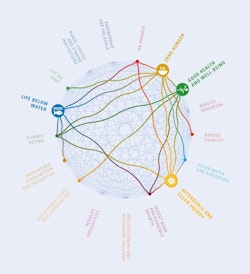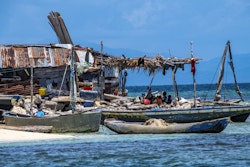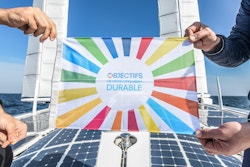Building resilience in our human societies at the time of COVID
This week marks the 5th anniversary of the United Nations Sustainable Development Goals. After years of progress, the sanitary crisis of 2020 has affected the advancements made in many of these goals. Dr. Katia Nicolet, the scientific advisor of Energy Observer, invites us to explore the links between nature, human development and disease outbreaks. By acknowledging our dependency to the natural world, we can start building resilience in our human societies.

The mangroves from the sky
Ecosystem services
Land and water-based ecosystems and the biodiversity they support provide food, clean water and clean air essential for human life. Forests cover almost one third of the Earth’s land area and the ecosystem services they provide are invaluable. Forest ecosystems maintain, regulate and improve soil fertility and stability helping to mitigate the effects of storms, floods and other natural disasters, while at the same time synthesizing half of the oxygen in the atmosphere. Containing over 80% of terrestrial biodiversity, forests provide the raw materials for economic growth. In 2011, the economic value of forests globally was estimated at 16.2 trillion dollars. Forested watershed and wetlands act to clean and filter water, supplying close to 75% of the world’s fresh water.
Oceans are another essential ecosystem without which human life would not be possible on earth. Covering more than 70% of the Earth’s surface, the ocean regulates the global climate and weather systems, supports nutrient cycling and primary production and generates our atmosphere. The oceans produce 50% of the oxygen we breath and are responsible for the absorption of 10 gigatonnes of CO2 per year. More importantly, most of the sun’s heat entering at the equator is redistributed by ocean currents towards the poles, creating the climatic conditions present on earth. The oceans also absorb up to 90% of the excess heat produced by human activities, making it the largest buffer against climate change that we have. The Oceans are home to 80% of all living organisms on earth and provide the main source of protein for tropical developing countries.

The interconnexion between the Sustainable development Goals
Ecosystems and their services are intricately connected to each other. Oceans provide food for humanity, regulate the climate, and generate the weather systems that produce clouds and rainfall over land. Rain is filtered by forests and wetlands to produce clean drinking water to support life. These ecosystem services are the basis for a healthy and prosperous human life.
Unfortunately, population growth, agricultural intensification and urbanization are causing rapid environmental destruction. Agriculture, for example, accounts for 70% of the global water withdrawal. As a result, 2.2 billion people are affected by water stress, lacking access to clean drinking water. Through deforestation, overfishing and the intensification of climate-related natural disasters, human impacts are degrading natural habitats, leading to species extinctions, decreased biodiversity, and the loss of ecosystem services.
Interconnection of Sustainable Development Goals
The United Nations Sustainable Development Goals (SDGs) were launched in 2015 in an effort to end poverty and set the world on a path of peace, prosperity and opportunity for all on a healthy planet. Every citizen has the right to safe drinking water, sufficient food, adequate sanitation, access to clean affordable energy, education and health care. The 17 SDGs demand nothing short of a transformation of our societies to guarantee these human rights in all countries.
However, one goal cannot be met on its own, they represent a highly-integrated web of challenges that cannot be divided. Fortunately, a large majority of these goals are positively connected, where working towards achieving one goal helps solve another. In a recent study, the International Council for Science has explored the interlinkages between the 17 SDGs and their 169 targets, and found that out of the 316 interactions identified, 238 of them were positive, 66 negative and 12 neutral. Most goals and targets are thus working in synergy, where one benefits another. The study did highlight, nonetheless, the need for coordinated policies to ensure some of the goals be met within environmental limits.
Interconnection between nature and SDGs: the COVID wakeup call

SDGs challenges in developing countries
Safe, healthy and prosperous human life cannot be achieved without strong, resilient ecosystems providing their vital services. For example, a decline in ocean health and productivity, due to increasing human pressures, is a major threat to food security, livelihoods and economic growth, especially for coastal communities. We would not be able to breath without the oceans and the forests of this earth. Human life cannot be separated from nature.
This has never been more evident than today, when the entire human population is facing an unprecedented pandemic, leaving virtually no country untouched. The COVID-19 is a zoonotic disease, meaning a disease able to spread between animals and people. These types of viruses are relatively common and have caused other epidemics before, such as Ebola, the Spanish flu or HIV. Zoonotic disease outbreaks have increased in the past few decades, and this phenomenon is likely the result of habitat destruction.
The correlation between emergence of new diseases and habitat degradation can be explained by two factors. The first is an increase of direct contact between animals and people as human expansion destroys and/or fragments natural habitats. Having lost their home, animals venture into populated areas, and humans enter remaining pockets of forests to collect raw material, hunt and catch wildlife for trade. The second factor is the loss of biodiversity. As some species disappear, others like rats and bats become more numerous. Few species replace many, and they tend to be the ones hosting pathogens able to spread to humans.
Risks of outbreaks are thus linked to land use, biodiversity, climate, and socio-economic factors such as population wealth and opportunities. If they have no other choices, people will continue to take down forests to make a living.
“Sustainable development is crucial. If we continue to have this level of deforestation, disorganized mining and unplanned development, we are going to have more outbreaks.””
How COVID impacted years of progress
The crisis disrupted the advancements made towards many of the SDGs, and even turned back years of progress in some cases. The United Nations Sustainable Development Goals Report for 2020 warns that the pandemic will push 71 million people back into extreme poverty by the end of the year. This would be the first time since 1998 that we would see a rise in global poverty. Unsurprisingly, the disease affected the most vulnerable people the most, the ones working in informal economy, living in inadequate housings with limited access to basic healthcare and services.
The disease also disproportionally affected women and slowed down the progress towards equality. Women account for 70% of the health and social workers on the front line of the pandemic, making them more at risk of catching the virus. The lockdowns throughout the world also drastically increased the cases of domestic violence, increasing by 30% in some countries. And while women already spend three times as much time in unpaid domestic work as men, the pandemic added extra burdens and unpaid care work.
The economic impacts are equally sobering, with the worst global recession in generations. Wealthy countries are already struggling to prevent economic collapse, but the poorest nations will inevitably be the most impacted. Some countries are already facing acute food insecurity and the ramifications of the COVID crisis will only aggravate their vulnerability.

Energy Observer, first French ambassador for the Sustainable development goals
Building resilience
The key word for tomorrow must be resilience. Resilience in the earth ecosystems and resilience in human societies. Building this resilience will be the only way we can recover from this sanitary crisis and better prepare for the bigger underlying cause: climate change.
The good news is, nature is inherently resilient. All we have to do is give ecosystems time to recover by reducing man-made pressures on these systems. By reducing our CO2 emissions, limiting discharges of pollutants in natural environments, halting deforestation and regenerating some lost habitats, nature will recover. Humanity cannot prosper without the services ecosystems provide, it is up to us to sustainably manage these natural resources to ensure a healthy earth for future generations.
Human resilience is also built in our DNA. While exacerbating our vulnerabilities, the COVID crisis has equally emphasised our strengths. Humans adapt, they problem solve, they find new ways to live, create and connect with each other. All we need is a blueprint for a better future, and in fact, the principals on which the SDGs were established are keys to building that future. The Goals are leading the way and can help leaders focus on inclusion, equity and sustainability while finding an economic stability.
The solutions are here and we can make it happen.
Downloads
- SDGs Guide to Interactions - International Science Council (English only) 9.0 MB, PDF Download